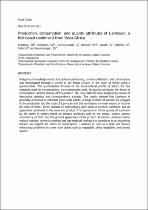 ResearchSpace
ResearchSpace
Production, consumption, and quality attributes of Lanhouin, a fish-based condiment from West Africa
JavaScript is disabled for your browser. Some features of this site may not work without it.
- ResearchSpace
- →
- Research Publications/Outputs
- →
- Journal Articles
- →
- View Item
| dc.contributor.author |
Kindossi, JM

|
|
| dc.contributor.author |
Anihouvi, VB

|
|
| dc.contributor.author |
Vieira-dalodé, G

|
|
| dc.contributor.author |
Akissoé, NH

|
|
| dc.contributor.author |
Jacobs, A

|
|
| dc.contributor.author |
Dlamini, N

|
|
| dc.contributor.author |
Pallet, D

|
|
| dc.contributor.author |
Hounhouigan, DJ

|
|
| dc.date.accessioned | 2013-03-25T06:20:45Z | |
| dc.date.available | 2013-03-25T06:20:45Z | |
| dc.date.issued | 2012-05 | |
| dc.identifier.citation | Kindossi, JM, Anihouvi, VB, Vieira-dalodé, G, Akissoé, NH, Jacobs, A, Dlamini, N, Pallet, D and Hounhouigan, DJ. 2012. Production, consumption, and quality attributes of Lanhouin, a fish-based condiment from West Africa. Food Chain, vol. 2(1), pp 1-14 | en_US |
| dc.identifier.issn | 2046-1879 | |
| dc.identifier.uri | http://www.ingentaconnect.com/content/itpub/fc/2012/00000002/00000001/art00009 | |
| dc.identifier.uri | http://hdl.handle.net/10204/6588 | |
| dc.description | © Practical Action Publishing, 2012. The definitive, peer-reviewed and edited version of this article is published in Food Chain, volume 2, issue 1, pages 117-130, 2012, http://practicalaction.org/publishing/foodchain | en_US |
| dc.description.abstract | Indigenous knowledge related to Lanhouin processing, commercialization, and consumption was investigated through a survey in the Mono District in the south of Benin using a questionnaire. The questionnaire focused on the socio-cultural profile of actors, the raw materials used for the processing, the technologies used, the quality attributes, the forms of consumption, and the storage of the product. The data collected were analysed by means of descriptive statistics and correspondence analysis. The results showed that Lanhouin is generally processed in informal small-scale plants. A large number of women are engaged in the production and the trade of Lanhouin and this constitutes the main source of income for most of them. Three variants of technologies were used to produce Lanhouin, but all apparently concluded in the same end product. The appreciation of the quality of Lanhouin by the actors is mainly based on sensory attributes such as the colour, texture, aroma, consistency of flesh, and the general appearance of the product. In Benin, Lanhouin serves various markets: domestic markets and sub-regional markets that contribute to an expanding market. As regards the forms of consumption, Lanhouin is used as a taste and flavour enhancing condiment in some main dishes such as vegetable, slimy vegetable, and tomato sauces. | en_US |
| dc.language.iso | en | en_US |
| dc.publisher | Practical Action Publishing | en_US |
| dc.relation.ispartofseries | Workflow;10326 | |
| dc.subject | Lanhouin processing | en_US |
| dc.subject | Fermentation | en_US |
| dc.subject | Commercialization | en_US |
| dc.subject | Indigenous knowledge | en_US |
| dc.subject | Lanhouin processors | en_US |
| dc.title | Production, consumption, and quality attributes of Lanhouin, a fish-based condiment from West Africa | en_US |
| dc.type | Article | en_US |
| dc.identifier.apacitation | Kindossi, J., Anihouvi, V., Vieira-dalodé, G., Akissoé, N., Jacobs, A., Dlamini, N., ... Hounhouigan, D. (2012). Production, consumption, and quality attributes of Lanhouin, a fish-based condiment from West Africa. http://hdl.handle.net/10204/6588 | en_ZA |
| dc.identifier.chicagocitation | Kindossi, JM, VB Anihouvi, G Vieira-dalodé, NH Akissoé, A Jacobs, N Dlamini, D Pallet, and DJ Hounhouigan "Production, consumption, and quality attributes of Lanhouin, a fish-based condiment from West Africa." (2012) http://hdl.handle.net/10204/6588 | en_ZA |
| dc.identifier.vancouvercitation | Kindossi J, Anihouvi V, Vieira-dalodé G, Akissoé N, Jacobs A, Dlamini N, et al. Production, consumption, and quality attributes of Lanhouin, a fish-based condiment from West Africa. 2012; http://hdl.handle.net/10204/6588. | en_ZA |
| dc.identifier.ris | TY - Article AU - Kindossi, JM AU - Anihouvi, VB AU - Vieira-dalodé, G AU - Akissoé, NH AU - Jacobs, A AU - Dlamini, N AU - Pallet, D AU - Hounhouigan, DJ AB - Indigenous knowledge related to Lanhouin processing, commercialization, and consumption was investigated through a survey in the Mono District in the south of Benin using a questionnaire. The questionnaire focused on the socio-cultural profile of actors, the raw materials used for the processing, the technologies used, the quality attributes, the forms of consumption, and the storage of the product. The data collected were analysed by means of descriptive statistics and correspondence analysis. The results showed that Lanhouin is generally processed in informal small-scale plants. A large number of women are engaged in the production and the trade of Lanhouin and this constitutes the main source of income for most of them. Three variants of technologies were used to produce Lanhouin, but all apparently concluded in the same end product. The appreciation of the quality of Lanhouin by the actors is mainly based on sensory attributes such as the colour, texture, aroma, consistency of flesh, and the general appearance of the product. In Benin, Lanhouin serves various markets: domestic markets and sub-regional markets that contribute to an expanding market. As regards the forms of consumption, Lanhouin is used as a taste and flavour enhancing condiment in some main dishes such as vegetable, slimy vegetable, and tomato sauces. DA - 2012-05 DB - ResearchSpace DP - CSIR KW - Lanhouin processing KW - Fermentation KW - Commercialization KW - Indigenous knowledge KW - Lanhouin processors LK - https://researchspace.csir.co.za PY - 2012 SM - 2046-1879 T1 - Production, consumption, and quality attributes of Lanhouin, a fish-based condiment from West Africa TI - Production, consumption, and quality attributes of Lanhouin, a fish-based condiment from West Africa UR - http://hdl.handle.net/10204/6588 ER - | en_ZA |





